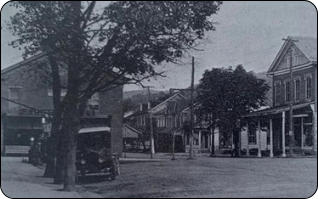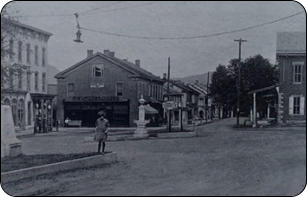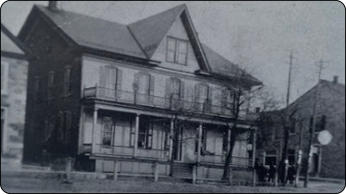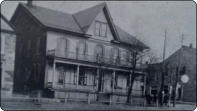



© millerstown.org 2025
Memories of Millerstown: Past Businesses and Buildings by Nathan Lesh - 25 January 2022
Time has done no favors for many local buildings and businesses that once held the threads of this community
together. Some businesses are now but distant memories that hearken back to those simpler times. Many older
buildings still stand but have changed drastically with the advent of vinyl siding and tin roofing. Though not all have
been so lucky, some buildings that once graced this town are lost forever. This article will detail several of these
forgotten businesses and buildings that helped to grow Millerstown, as well as
detail their importance to the community.
Commerce in the Millerstown Town Square
The building JoJo’s Pizza now resides in hasn't always been a pizza shop, as many
know. The building has been a staple in Millerstown’s relatively small skyline for
well over 100 years. On the plot of land was a dry goods and grocery store, built
sometime before 1878. It was affectionately nicknamed Cluck’s Corner and was run by Mr. Thomas Cluck. It was a
popular shop for any early Millerstown resident to buy their groceries and supplies. So when fire ravaged the building in
1878, it was immediately rebuilt. Cluck operated the business for several more years before eventually selling the
property to T.P. Cathcart, who then sold the business to D.W. Heefner. Afterward, it followed another maze of owners
until the business was sold in 1946 to Roy and Harold Gelnett. They operated the business for several years before
selling the market in 1963 to the Swegers. By the time of the store's closure, it had been the longest continuously
operated market in town. Eventually, the property became what we now know as JoJo’s Pizza.
On the corner of Millerstown where the
Juniata Valley Bank now resides, a Gulf
station sat on the lot before the bank. More
importantly, even before the Gulf station sat
a
hotel. The hotel was named the Ward
House. The Ward house was a grand hotel
and offered travelers a quiet and nice rest.
You would be glad to park your early Ford
model T or A in front of the establishment. The hotel was of timber frame design and
had a large front porch that faced the town square. It had a large grand wooden
staircase and mahogany banister. The hotel got its name from the original owner
Huffer Ward. Ward later sold the business to George Rebok. Rebok grew the hotel into a well-established business. The
business was later sold to Peter Shenk who also ran a bottling works and
movie theatre along with the hotel. Throughout the hotel's operation, there
have been numerous famous guests. One famous customer that was widely
talked about was Alexander Graham Bell who was traveling to Canada with
his wife. Governor Gifford Pinchot of Pennsylvania also spent time at the
hotel while he was chasing votes. Sadly, the hotel caught fire in 1941. The
historic building was a total loss.
On the northernmost corner of Millerstown, across from the present-day Firehall, sits the remains of Rickabaugh’s Dry
Goods Store. The building was very spacious and had large aisles stocked full of merchandise. David Rickabaugh, the
original owner, had a large coffee grinder in the store where townspeople could get any number of their preferred
coffee grounds. When Rickabaugh built his store, there was a large second story that was built as well. This was rarely
used by David, so he rented it out for many community groups and town
council meetings.
Directly across from the Rickabaugh store there was another dry goods store
operated by the Brandt family. Eventually, the store was purchased by the
popular franchise Atlantic and Pacific Food
Markets, or just A&P for short. A glass-front faced the square for all to see the many wares they sold.
One popular deal was a small barrel of pickles for 3 cents.
Directly beside the Millerstown Firehall to the left was the Millerstown Hardware Store. The store operated until 1906.
Ralph Thompson started the business until he sold the operation in 1925 to Ralph Beaver. The business then passed
through a myriad of owners until the hardware store's eventual closure. In its heyday, kids were rumored to think of the
place as spooky, so they kept their distance from the store. In the same building, a laundromat was also available for
townspeople. Strangely, the post office was housed in the laundromat. In the spring when the hatcheries shipped chicks
by rail car, the laundromat would be full of tiny chirps from the birds. All those chickens in the laundromat, even if they
were in a box, would be a dirty operation.
The Tannery
One of the most famous and well-known businesses in the Millerstown area was the Rippman Tannery. The Tannery
was built in 1800 by Joshua North, it was constructed near the Savercool home across the street and down from Stitch
in Time. The property passed through a series of owners until 1849. This time it was sold to Henry Hopple for $2,500,
roughly $80,000 when adjusted for inflation. It wouldn't be long before it was sold again, but Mr. Hopple brought about
new innovations. One major change was the introduction of steam to the tanning operation. The company was in
Joseph Howell’s name until 1882 when he was forced to sell the property due to financial issues.
Charles A. Rippman purchased the property after Hopple and made the business boom. Rippman, like others, brought
modern practices to the hide tanning operation and received great accolades. At the 1893 Chicago World’s fair Rippman
was recognized for his oak tanned foot sole leather. The Rippmans became very affluent thanks to their tanning
success. They were the first to bring a bathtub to their home. It was connected to the steam machines at the tannery
and was manufactured by local tinsmiths. In 1945, the property was sold to R.C. Savercool. A portion of the facilities
were also sold to Precisionware, later named Triangle Pacific. Triangle Pacific later moved to Thompsontown after a fire
in the old tannery buildings in 1954. There, they were later bought out and restructured several times. Now the
company is currently operating under the name ACPI Cabinetworks Group. Only a handful of buildings from the original
tannery still remain. One notable structure is the tall smokestack which still towers over the property.
Millerstown was once a great economical hub in the county. While Millerstown
still may be an economic hub, it, unfortunately, has lost many companies and
operations that put the “town” in Millerstown. Every business mentioned above,
whether big or small, has led to some change in the town and brought
Millerstown through every challenge and endeavor it may have been faced with.
When one business door closed, another opened. Much like the many owners of
the Rippman tannery and their entrepreneurial spirit that guided their business
to great success. Even though the tannery and many other businesses have ceased operations, Millerstown will always
retain its ability to persevere and it's history that brought it where it is today.
Contributed for re-use on this website by Nathan Lesh - 25 January 2022
Staff Writer for The Paw Print - Greenwood High School Journalism Club
Works Cited:
Millerstown and Area, 200 Years along the Juniata. Millerstown Bicentennial Committee, 1980.
Taylor, Janet. African Americans in Perry County: 1820-1925. Huggins Printing Co., 2011.
Gilmore, Linda Martin. Celebrating 200 Years of History in Perry County, Pennsylvania. Linda Martin Gilmore, 2019.
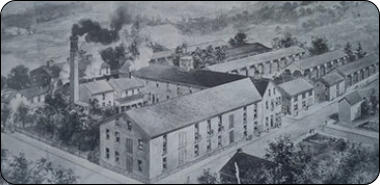
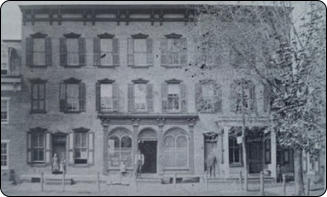
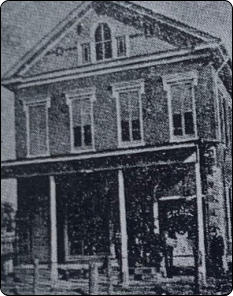
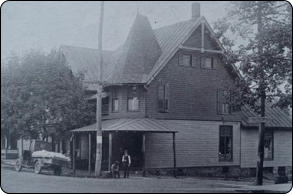
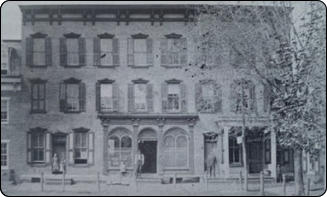




© millerstown.org 2025
millerstown.org
Memories of Millerstown: Past Businesses
and Buildings
by Nathan Lesh - 25 January 2022
Time has done no favors for many local buildings and
businesses that once held the threads of this community
together. Some businesses are now but distant memories
that hearken back to those simpler times. Many older
buildings still stand but have changed drastically with the
advent of vinyl siding and tin roofing. Though not all have
been so lucky, some buildings that once graced this town are
lost forever. This article will detail several of these forgotten
businesses and buildings that
helped to grow Millerstown, as
well as detail their importance to
the community.
Commerce in the Millerstown Town Square
The building JoJo’s Pizza now resides in hasn't always been a
pizza shop, as many know. The building has been a staple in
Millerstown’s relatively small skyline for well over 100 years.
On the plot of land was a dry goods and grocery store, built
sometime before 1878. It was affectionately nicknamed
Cluck’s Corner and was run by Mr. Thomas Cluck. It was a
popular shop for any early Millerstown resident to buy their
groceries and supplies. So when fire ravaged the building in
1878, it was immediately rebuilt. Cluck operated the business
for several more years before eventually selling the property
to T.P. Cathcart, who then sold the business to D.W. Heefner.
Afterward, it followed another maze of owners until the
business was sold in 1946 to Roy and Harold Gelnett. They
operated the business for several years before selling the
market in 1963 to the Swegers. By the time of the store's
closure, it had been the longest continuously operated
market in town. Eventually, the property became what we
now know as JoJo’s Pizza.
On the
corner of
Millerstown
where the
Juniata
Valley Bank now resides, a Gulf station
sat on the lot before the bank. More
importantly, even before the Gulf
station sat a hotel. The hotel was named the Ward House.
The Ward house was a grand hotel and offered travelers a
quiet and nice rest. You would be glad to park your early Ford
model T or A in front of the establishment. The hotel was of
timber frame design and had a large front porch that faced
the town square. It had a large grand wooden staircase and
mahogany banister. The hotel got its name from the original
owner Huffer Ward. Ward later sold the business to George
Rebok. Rebok grew the hotel into a well-established business.
The business was later sold to Peter Shenk who also ran a
bottling works and movie theatre along with the hotel.
Throughout the hotel's operation, there have been numerous
famous guests. One famous customer that was widely talked
about was Alexander Graham Bell
who was traveling to Canada with
his wife. Governor Gifford Pinchot
of Pennsylvania also spent time at
the hotel while he was chasing
votes. Sadly, the hotel caught fire in
1941. The historic building was a
total loss.
On the northernmost corner of Millerstown, across from the
present-day Firehall, sits the remains of Rickabaugh’s Dry
Goods Store. The building was very spacious and had large
aisles stocked full of
merchandise. David
Rickabaugh, the original
owner, had a large coffee
grinder in the store where
townspeople could get any
number of their preferred coffee grounds. When Rickabaugh
built his store, there was a large second story that was built
as well. This was rarely used by David, so he rented it out for
many community groups and town council meetings.
Directly across from the
Rickabaugh store there was
another dry goods store
operated by the Brandt
family. Eventually, the store
was purchased by the popular
franchise Atlantic and Pacific Food Markets, or just A&P for
short. A glass-front faced the square for all to see the many
wares they sold. One popular deal was a small barrel of
pickles for 3 cents.
Directly beside the Millerstown Firehall to the left was the
Millerstown Hardware Store. The store operated until 1906.
Ralph Thompson started the business until he sold the
operation in 1925 to Ralph Beaver. The business then passed
through a myriad of owners until the hardware store's
eventual closure. In its heyday, kids were rumored to think of
the place as spooky, so they kept their distance from the
store. In the same building, a laundromat was also available
for townspeople. Strangely, the post office was housed in the
laundromat. In the spring when the hatcheries shipped chicks
by rail car, the laundromat would be full of tiny chirps from
the birds. All those chickens in the laundromat, even if they
were in a box, would be a dirty operation.
The Tannery
One of the most famous and well-known businesses in the
Millerstown area was the Rippman Tannery. The Tannery was
built in 1800 by Joshua North, it was constructed near the
Savercool home across the street and down from Stitch in
Time. The property passed through a series of owners until
1849. This time it was sold to Henry Hopple for $2,500,
roughly $80,000 when adjusted for inflation. It wouldn't be
long before it was sold again, but Mr. Hopple brought about
new innovations. One major change was the introduction of
steam to the tanning operation. The company was in Joseph
Howell’s name until 1882 when he was forced to sell the
property due to financial issues.
Charles A. Rippman purchased the property after Hopple and
made the business boom. Rippman, like others, brought
modern practices to the hide tanning operation and received
great accolades. At the 1893 Chicago World’s fair Rippman
was recognized for his oak tanned foot sole leather. The
Rippmans became very affluent thanks to their tanning
success. They were the first to bring a bathtub to their home.
It was connected to the steam machines at the tannery and
was manufactured by local tinsmiths. In 1945, the property
was sold to R.C. Savercool. A portion of the facilities were also
sold to Precisionware, later named Triangle Pacific. Triangle
Pacific later moved to Thompsontown after a fire in the old
tannery buildings in 1954. There, they were later bought out
and restructured several times. Now the company is currently
operating under the name ACPI Cabinetworks Group. Only a
handful of buildings from the original tannery still remain.
One notable structure is the tall smokestack which still towers
over the property.
Millerstown was once a great
economical hub in the county.
While Millerstown still may be an
economic hub, it, unfortunately,
has lost many companies and
operations that put the “town” in
Millerstown. Every business mentioned above, whether big or
small, has led to some change in the town and brought
Millerstown through every challenge and endeavor it may
have been faced with. When one business door closed,
another opened. Much like the many owners of the Rippman
tannery and their entrepreneurial spirit that guided their
business to great success. Even though the tannery and many
other businesses have ceased operations, Millerstown will
always retain its ability to persevere and it's history that
brought it where it is today.
Contributed for re-use on this website by Nathan Lesh - 25
January 2022
Staff Writer for The Paw Print - Greenwood High School
Journalism Club
Works Cited:
Millerstown and Area, 200 Years along the Juniata.
Millerstown Bicentennial Committee, 1980.
Taylor, Janet. African Americans in Perry County: 1820-1925.
Huggins Printing Co., 2011.
Gilmore, Linda Martin. Celebrating 200 Years of History in
Perry County, Pennsylvania. Linda Martin Gilmore, 2019.
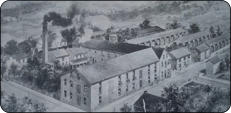

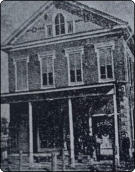
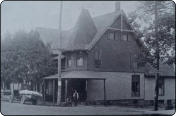


- index
- Borough govt
- Events
- Park
- Pool
- Fire Ambulance
- Senior Center
- Links
- History
- Agenda
- Meetings schedule
- Schools
- Churches
- Businesses
- Mcsi
- Reservations
- Pavilions
- Community room
- Kitchen
- Amphitheater
- Bill due dates
- Useful info
- Nuisances
- Nuisances 2
- Animals & livestock
- Rtk request
- Rtk policy
- Historic tidbits
- Perry county facts
- Surrounding townships
- Cochran anspach
- Historic town places
- Notable people
- Buildings
- Controversial past
- march 2025 minutes
- Buildings part 2
- november 2024 minutes
- february 2025 minutes
- senior center
- park minutes
- Blank-an
- Brush pickup
- april 2025 minutes
- december 2024 minutes
- january 2025 minutes
- Blank-ao
- Blank-ap
- contact
- Blank-aq
- Blank-ar
